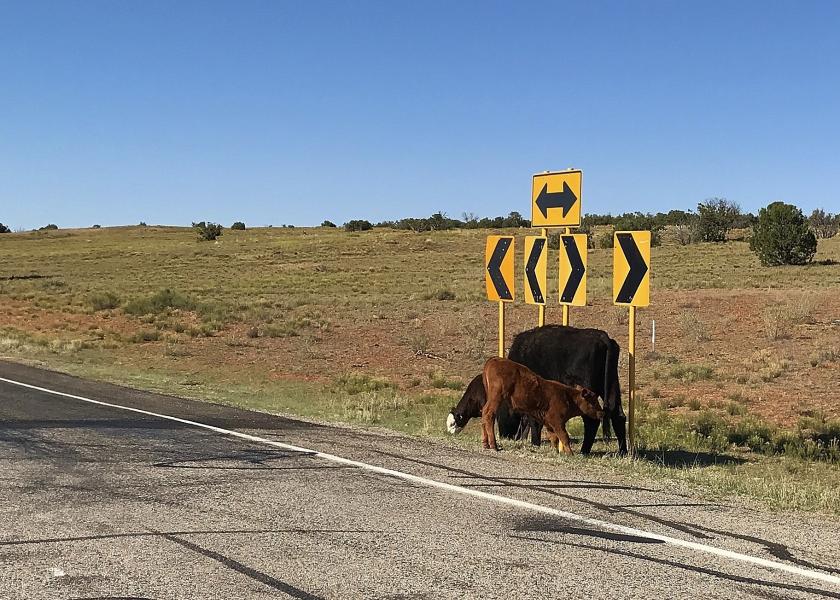Can You Capture Gain from Drought-Stressed Calves?

How can you help ensure drought-stressed calves get an opportunity to capture a greater gain than they would otherwise?
During a drought, early weaning creates an avenue for the nutritional needs of the calf to be met, according to Dr. Phillip Kesterson, a member of the Zoetis beef technical service team.
“By providing a well-balanced ration in appropriate quantities, we allow the calves to achieve their genetic performance potential, and to likely remain much healthier,” Kesterson said.
Performance advantages
Research has shown that early weaned calves can present unique performance advantages when placed in a feedlot and started on an energy-dense, protein-rich ration, containing sufficient roughage. A ration of this type is directly associated with lower dry matter intake often associated with smaller calves, according to Dr. Catherine Maguire, Zoetis technical services veterinarian.
“Calves weaned early have demonstrated statistically superior gains, feed efficiency and grading on the rail than their conventionally weaned counterparts when started on a high concentrate ration like what we typically see implemented as a finishing ration,” Maguire explained.1
She added that a large percentage of calves fed and managed that way have been documented to grade choice or prime on the USDA Quality Grade scale, representing a distinct advantage to producers who retain ownership of calves through the feeding period.
Strategies for success
Early weaning can be a useful management tool to help producers navigate drought. Maguire outlined these five tips to help cattlemen achieve early weaning success:
1. Manage stress. Low stress cattle handling techniques when weaning, shipping and receiving early weaned calves is critical, Maguire said.
“It’s vitally important to get these calves acclimated to dry lots and on feed and water promptly upon arrival to feedyards,” she said. “Stress at large can serve as an impetus for the development of bovine respiratory disease (BRD) in cattle so limiting stress around weaning is imperative.”
2. Oversee pen size. Early weaned, smaller calves might require unique adaptations to conventional feedlot pens designed for larger calves weaned later in the fall.
“Smaller pens can decrease excessive pen perimeter walking of freshly weaned calves and can encourage calves to get on feed and water quickly,” Maguire explained.
3. Adjust water and feed sources. Smaller calves might have trouble navigating traditional water troughs and feed bunks. Consider building up the ground around water troughs and feed bunk aprons with clay or other foundational material to accommodate a smaller calf’s limited reach.
Maguire said decreasing the physical space in the feed bunk can be helpful by limiting the number of calves that escape the pen. It can also assist in ration management due to a small calf’s limited reach and inability to reach the far side of a feed bunk compared to an older calf.
According to Maguire, one example might be to lean sheet metal at a slant in the bunk to keep the feed closer to the cattle and into their reach.
4. Consider the immune system. Maguire said one major difference between an early weaned calf and a calf weaned at a more conventional time later in the year is the maturity of their respective immune systems.
“In cattle, the immune system is not considered mature until about 5 to 8 months of age, and until that point it cannot mount as robust or rapid of a response to disease challenges,” Maguire explained.
A less mature immune system is easier for disease insults to override and cause detrimental health and performance impacts, she added.
5. Review calf nutrition. Dietary considerations should be discussed with a nutritionist when formulating rations for early weaned calves, Maguire said.
“A nursing calf will typically gain just over 2 lbs. per day, so that can serve as a target for an early weaned calf on arrival,” Maguire said. “Palatable rations with little variability in size of components tend to be the most approachable for nursing calves transitioning to starter diets.”
Is early weaning right for you?
While early weaning is a good option for many cattlemen when drought sets in, you should first consider an overall weaning strategy as well as temperature, marketing and ownership retention strategies.
If cattle are grazing summer pasture when early weaning will take place, Maguire said challenges could exist with working facility limitations. Fence-line weaning, or a similar, gradual approach is often a good option for reducing stress on calves while benefiting the animal’s health and performance, she added.
High temperatures should be considered at all stages of cattle processing, and especially when early weaning as younger calves can become tired and dehydrated more quickly than their older counterparts.
Maguire anticipates dust control to be a major challenge this fall, especially when cattle are worked or transported.
“Research has demonstrated that dust can be a physical irritant to the respiratory tract and can also serve as a carrier of pathogenic agents,” Maguire said. “Dust irritation can compound with stressors such as weaning, processing, heat dietary changes, weather events and potential disease challenges and increase a calf’s propensity to develop clinical bovine respiratory disease (BRD).”
Finally, Maguire said retaining ownership of early weaned cattle allows producers to capitalize on the superior gains and feed conversion of the calves and bolster the profitability of that calf crop.
1 Myers, 1999.
Sponsored by Zoetis







